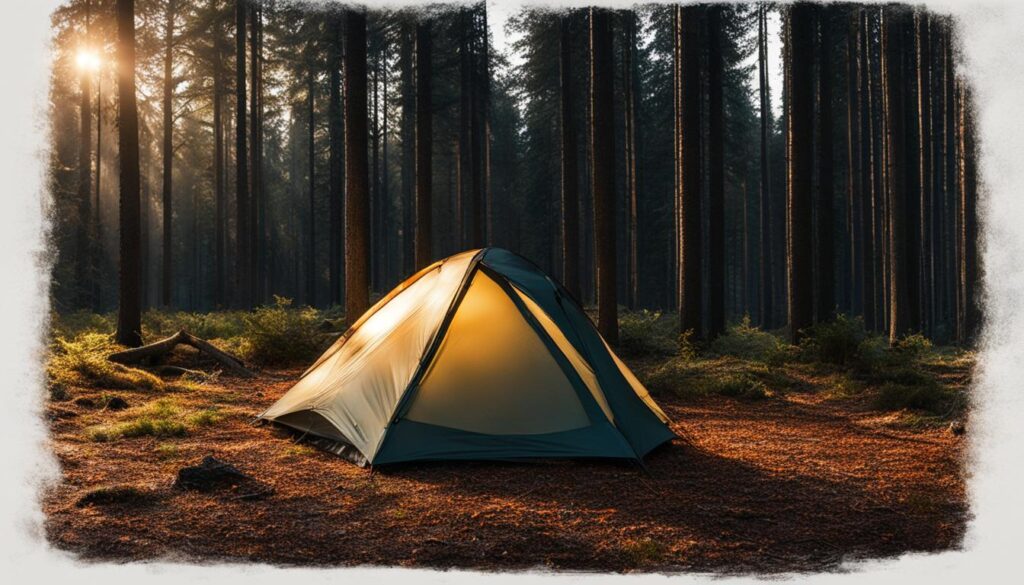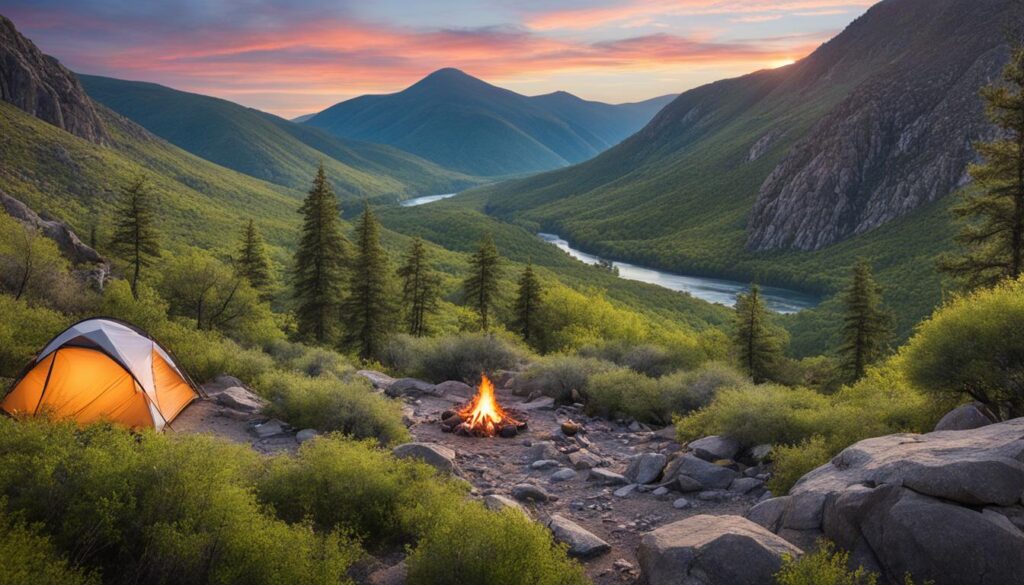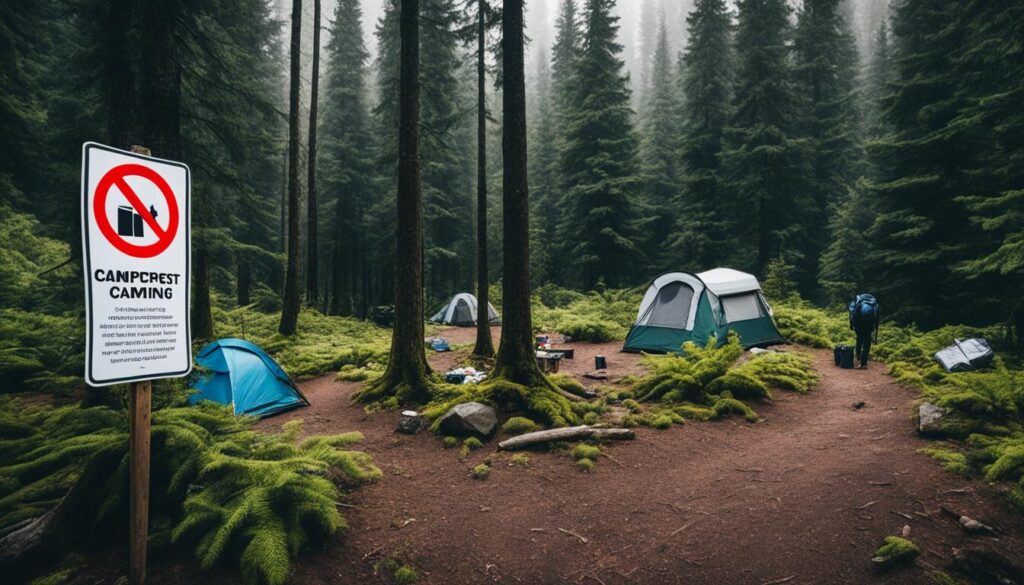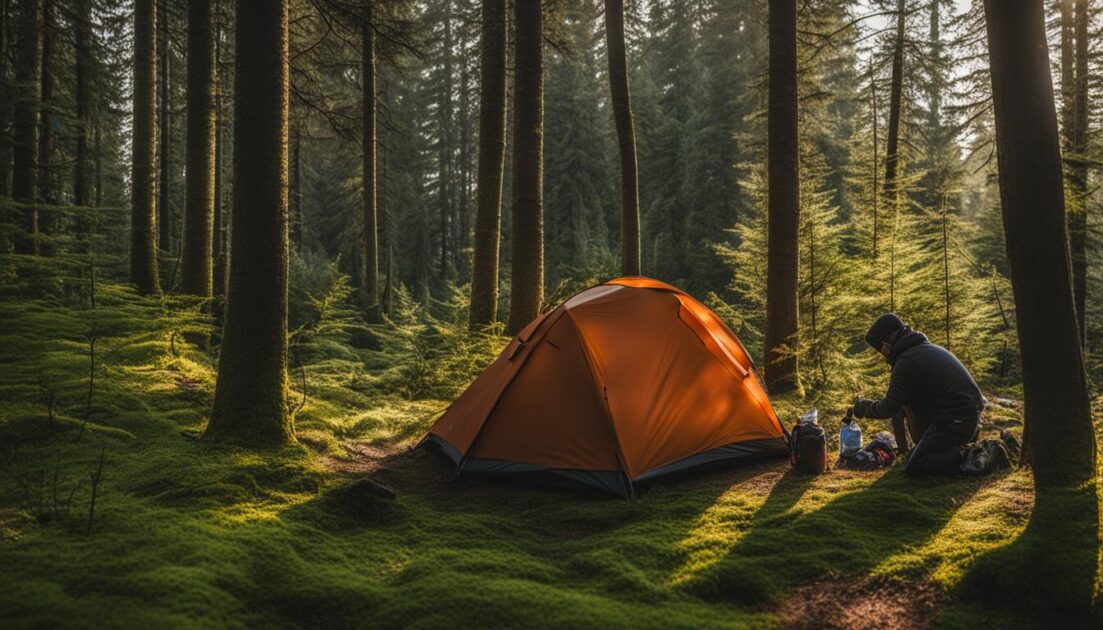Stealth camping – a term that may evoke intrigue and curiosity. What exactly is it, and why has it become a popular alternative to traditional camping? In this guide, I will provide a comprehensive overview of stealth camping, its benefits, essential tips, and the ethics behind this unique outdoor experience.
Key Takeaways
- Stealth camping involves camping in unconventional and undesignated areas.
- It offers an adventurous way to experience nature, away from crowded campsites.
- Understanding the legal and ethical aspects of stealth camping is essential.
- Researching and choosing suitable camping spots is crucial for a successful trip.
- Respecting the environment and leaving no trace are key ethical considerations.
What is Stealth Camping?
Stealth camping is a unique and adventurous way to experience the great outdoors. It involves camping in places where camping is not typically allowed, such as private property or areas without designated campsites. This practice allows campers to immerse themselves in nature while enjoying a more secluded camping experience.
There are different types of stealth camping, each with its own characteristics:
- Urban Stealth Camping: Camping in urban areas, often in parks, rooftops, or other hidden spots within the city. This type of stealth camping offers the opportunity to experience the thrill of camping in an urban environment.
- Wild Stealth Camping: Camping in remote wilderness areas, away from established campsites. This type of stealth camping allows campers to explore untouched natural landscapes and enjoy solitude.
- Vehicle Stealth Camping: Camping in a vehicle, such as a camper van or SUV, often in parking lots or secluded areas. This type of stealth camping provides convenience and mobility for those who want to travel and camp simultaneously.
Advantages of stealth camping include the ability to camp in unique locations, away from crowded campsites, and a more intimate connection with nature. It offers a sense of adventure and freedom, as well as the opportunity to discover hidden camping spots. However, there are also disadvantages to consider:
- Disadvantages of Stealth Camping:
- Potential safety risks: Stealth camping in secluded areas may expose campers to wildlife encounters or unsafe environments.
- Legal consequences: Camping in restricted or private areas can lead to fines or penalties.
Before embarking on a stealth camping adventure, it is essential to understand the legality, safety considerations, and ethical implications:
- Legality of Stealth Camping: Research the rules and regulations for camping in the areas you plan to visit. Stealth camping may be prohibited in certain locations, and permits or permissions may be required.
- Safety Considerations of Stealth Camping: Be aware of potential risks in the chosen camping spot and prepare accordingly. It is vital to have adequate equipment, knowledge of the surroundings, and emergency plans.
- Ethical Considerations of Stealth Camping: Respecting the environment and private property are crucial. Follow Leave No Trace principles, leave the campsite as you found it, and be considerate of other campers and landowners.
By considering these factors, prospective stealth campers can enjoy a responsible and enjoyable camping experience while minimizing the negative impact on the environment and ensuring personal safety.

Next, in Section 3, we will explore the different camping spots where you can engage in stealth camping, including public lands, private lands, and state parks. We will provide insights and considerations for choosing the right location for your stealth camping adventure.
Where Can You Stealth Camp?
When it comes to stealth camping, finding the right camping spot is essential for a successful and enjoyable experience. Fortunately, there are various options available for stealth campers.
Public Lands for Stealth Camping
Public lands provide ample opportunities for secluded camping. National parks and forests offer vast areas where you can camp away from crowds and designated campsites. Additionally, BLM (Bureau of Land Management) lands and wilderness areas are ideal for those seeking to camp off the beaten path.
Stealth camping on public lands allows you to connect with nature and enjoy the peace and quiet of remote locations. However, it’s important to familiarize yourself with any regulations and restrictions that may be in place.
Private Lands for Stealth Camping
“Seeking permission from the landowner is crucial when considering private lands for stealth camping. It is essential to respect the rights and property of others.”
If you have access to private lands, stealth camping can be a possibility with the permission of the landowner. This could be an ideal option for those who know someone with land suitable for camping. Always ensure to follow any guidelines or restrictions set by the landowner to maintain a positive relationship.
State Parks for Stealth Camping
Some state parks allow backcountry or primitive camping, which can be a viable option for stealth campers. However, it is important to thoroughly research and familiarize yourself with the specific regulations of each state park beforehand.
While not all state parks allow stealth camping, those that do often have specific areas designated for backcountry camping. These areas provide opportunities to camp away from the traditional campsites and enjoy a more secluded experience.
Considerations for Choosing a Stealth Camping Spot
When choosing a stealth camping spot, several considerations should be taken into account:
- Regulations and permits: Ensure that camping is allowed in the chosen area and obtain any necessary permits.
- Respect for land and property owners: It is crucial to respect the land and property owners by following any guidelines or restrictions in place.
- Discretion and privacy: Look for spots that offer natural barriers or seclusion to maintain privacy and minimize the chance of detection.
- Access to resources: Consider proximity to water sources, firewood, and other amenities that may be necessary during your camping trip.

Choosing the right location for stealth camping is essential for a memorable and responsible camping experience. By considering public lands, private lands (with permission), and state parks with appropriate regulations, you can find the perfect spot to enjoy the beauty of nature while practicing responsible stealth camping.
Legal and Ethical Considerations of Stealth Camping
Stealth camping is an intriguing and adventurous way to experience the great outdoors. However, before embarking on a stealth camping adventure, it is essential to understand the legal and ethical considerations associated with this unconventional camping style. By adhering to regulations, minimizing environmental impact, and respecting private property, campers can ensure a positive and sustainable experience.
Legal Considerations
When engaging in stealth camping, it is crucial to research and understand the regulations and permits for the areas where you plan to camp. While stealth camping is all about camping off the beaten path, it is important to recognize that it may be prohibited in certain locations or during specific seasons. By familiarizing yourself with the legal considerations, you can avoid unnecessary legal trouble and enjoy your camping experience with peace of mind.
Environmental Impact
Stealth camping, when done responsibly, can minimize the environmental impact on the natural areas you visit. Following Leave No Trace principles is vital to preserve the integrity of the environment. This involves packing out all waste, using designated fire rings or stoves, and minimizing any damage to flora and fauna. By treading lightly and respecting nature, you can help preserve these valuable resources for future generations.
Ethical Considerations
Respecting private property and the rights of other individuals is paramount when engaging in stealth camping. It is essential to obtain permission from landowners before camping on private property, ensuring that you are not infringing upon someone else’s rights. Additionally, being considerate of other campers and hikers by keeping noise levels low and avoiding crowded areas contributes to a positive camping experience for everyone involved.
| Legal Considerations | Environmental Impact | Ethical Considerations |
|---|---|---|
| Research regulations and permits | Follow Leave No Trace principles | Obtain permission from landowners |
| Adhere to legal requirements | Minimize damage to flora and fauna | Respect the rights of other campers |
| Avoid prohibited areas | Minimize waste and pack out trash | Keep noise levels low |
Stealth camping can provide an unforgettable and unique camping experience. However, it is crucial to approach it with a responsible mindset. By considering the legal, environmental, and ethical aspects of stealth camping, you can ensure a positive and sustainable adventure in the great outdoors. Remember, leaving nature and private property undisturbed is not only ethical but also preserves these cherished landscapes for future generations.

Tips for Successful Stealth Camping
Successful stealth camping relies on careful planning and preparation. To ensure a safe and satisfying experience, here are some essential tips:
Choosing the Right Location for Stealth Camping
When selecting a stealth camping spot, it’s crucial to choose a location away from popular trails and campsites. Look for secluded areas where you are less likely to be discovered. Consider these factors when choosing a location:
- Proximity to populated areas
- Accessibility and ease of entry
- Vegetation for natural camouflage
- Elevation and topography for privacy
Essential Gear for Stealth Camping
To have a comfortable and successful stealth camping trip, make sure you have the following essential gear:
- A lightweight and compact tent
- A warm sleeping bag and sleeping pad
- A headlamp or flashlight for visibility
- Portable cooking equipment
- Water purification methods
- Weather-appropriate clothing and footwear
Setting Up Camp for Stealth Camping
When setting up camp, remember to be discreet and leave no trace. Follow these guidelines:
- Set up your tent in an inconspicuous spot, utilizing natural cover if possible.
- Minimize noise and avoid using bright lights that might attract attention.
- Avoid making unnecessary modifications to the surroundings.
- Keep your campsite tidy and dispose of waste properly.
Staying Safe during Stealth Camping
Even in secluded areas, safety should always be a priority. Follow these safety tips:
- Be aware of your surroundings and stay vigilant.
- Inform someone about your camping plans and expected duration.
- Pack a first aid kit and know basic first aid techniques.
- Research potential hazards in the area.
By following these tips, you can have a successful and enjoyable stealth camping experience while minimizing the risks and ensuring your safety.

Gear and Equipment for Stealth Camping
When it comes to stealth camping, having the right gear and equipment is essential for a successful and enjoyable experience. Here are some key items to consider:
Tent for Stealth Camping: Opt for a lightweight tent that is easy to set up and blends in with the surroundings. Camouflaged tents are ideal for remaining discreet in remote locations.
Sleeping Gear for Stealth Camping: Ensure you have a warm and comfortable sleeping bag designed for the specific weather conditions. A sleeping pad is also crucial for providing insulation and cushioning.
Lighting Equipment for Stealth Camping: Navigation in the dark can be challenging during stealth camping. Invest in a reliable headlamp or flashlight to safely move around your campsite and explore the surroundings.
Essential Items for Stealth Camping: Don’t forget to pack water purification methods to ensure a safe drinking supply. Cooking equipment, such as a lightweight stove and utensils, will allow you to prepare meals. A well-stocked first aid kit is crucial for any emergencies that may arise.
By selecting the appropriate gear for stealth camping, you can enhance your overall experience and ensure your safety in remote locations. Remember to always prioritize lightweight and compact items to minimize the load you carry while still being prepared for any situation that may arise.
FAQ
What is stealth camping?
Stealth camping is a way of camping where individuals camp in places where they are not supposed to camp, often in a sneaky and discreet manner.
What are the advantages of stealth camping?
Stealth camping offers the ability to camp in unique and secluded locations, providing a more adventurous and off-grid camping experience.
Are there any disadvantages to stealth camping?
Yes, there are disadvantages to consider when stealth camping, such as potential safety risks and legal consequences.
Where can you stealth camp?
Stealth camping can be done on public lands, private lands with permission, and some state parks that allow backcountry camping. It is important to research and follow specific regulations for each area.
What are the legal and ethical considerations of stealth camping?
Stealth camping raises legal considerations, requiring knowledge of regulations and permits for the areas where camping is planned. Ethically, it is important to minimize environmental impact and respect private property and other individuals using the land.
What tips can you provide for successful stealth camping?
Tips for successful stealth camping include choosing the right location away from popular areas, having essential gear, setting up camp discreetly, and practicing safe camping habits.
What gear and equipment are essential for stealth camping?
Essential gear for stealth camping includes a lightweight and camouflaged tent, sleeping gear, lighting equipment, water purification methods, cooking equipment, and a first aid kit.

